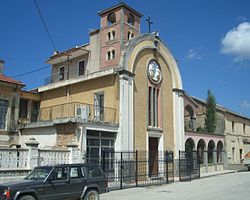Apostolic Administration of Southern Albania
| Apostolic Administration of Southern Albania | |
| Basic data | |
|---|---|
| Country | Albania |
| Metropolitan bishopric | Archdiocese of Tirana-Durrës |
| Apostolic Administrator | Giovanni Peragine CRSP |
| Apostolic Administrator Emeritus | Hil Kabashi OFM |
| founding | November 11, 1939 |
| surface | 16,172 km² |
| Parishes | 11 (2014 / AP 2015 ) |
| Residents | 2,140,000 (2014 / AP 2015 ) |
| Catholics | 3,596 (2014 / AP 2015 ) |
| proportion of | 0.2% |
| Diocesan priest | 1 (2014 / AP 2015 ) |
| Religious priest | 7 (2014 / AP 2015 ) |
| Catholics per priest | 450 |
| Friars | 11 (2014 / AP 2015 ) |
| Religious sisters | 82 (2014 / AP 2015 ) |
| rite | Roman rite |
| Liturgical language | Albanian |

The Apostolic Administration of Southern Albania ( Latin : Apostolica Administratio Albaniae Meridionalis ) is an administrative district of the Catholic Church in Albania , which is largely equivalent in its functions to an ordinary diocese . It covers the southern half of the Balkans from the Shkumbin River in the north to the Greek border in the south. The seat of the episcopal administrator is the port city of Vlora .
Officially, the southern Albanian administration has been a diocese since it was established in 1939. It is also the territory of the Albanian Greek Catholic Church in which the Byzantine rite is used. However, Catholic life, which in the predominantly Orthodox and Muslim southern Albania was only very poorly developed before the Second World War , was completely extinguished by the religious ban of the Albanian communists in 1967. The reconstruction that has begun in recent years is mainly being carried out by foreign priests and religious who come from the Latin tradition. That is why today the Catholics of southern Albania celebrate Holy Mass almost exclusively according to the Roman rite . Only one parish in Elbasan still maintains the Byzantine rite.
In the Albanian jurisdiction, which is the largest in terms of area, around 3,600 believers (2014) live and are looked after by eight priests. In addition, almost a hundred friars and sisters are active in southern Albania. In addition to eleven canonical parishes, there are a number of pastoral care stations for the very dispersed Catholics. The Apostolic Administrator has been Giovanni Peragine CRSP since 2017 . Its official seat has been Vlora since 2008 . In the same year, three Slovak Franciscans took over pastoral care in the former episcopal city of Fier .
history
The origins of the Catholic Albanians of the Eastern Rite go back to the period between 1628 and 1765, when small communities connected with Rome lived on the coasts of Epirus . Without any growth and weakened by numerous emigrants to Italy who became part of the Italo-Albanian Church , which still exists today , there was only a small boom at the turn of the 20th century, when an Orthodox priest converted and established a new congregation In 1912 there were already around 120 believers and by 1940 this had grown to around 400. Since 1938 the small community has found support from its fellow believers in the Italo-Byzantine churches , who had once started from them and who have now sent them some monks from the Grottaferrata Abbey . In the following year (1939) the Apostolic Administration was established; the first administrator was Leone Giovanni Battista Nigris . However, the apostolic delegate was expelled as early as 1945. In 2003 the administration of the Archdiocese of Durrës-Tirana was subordinated.
Apostolic Administrators of Southern Albania
- Leone Giovanni Battista Nigris (1940–1945, resigned)
- Vinçenc Kolë Prennushi OFM (1946–1949, died)
- Ivan Dias (1991–1996, also Apostolic Nuncio in Albania, then Archbishop of Bombay )
- Hil Kabashi OFM (1996-2017)
- Giovanni Peragine CRSP (since 2017)
literature
- Cordignano, Fulvio SJ: Geografia ecclesiastica dell'Albania. Dagli ultimi decenni del secolo XVI alla metà del secolo XVII. In: Orientalia Christiana Periodica. 36, pp. 229-294.
- Constantin Simon: Albania, un mosaico di religioni. In: La Civiltà Cattolica . 2005 / IV, pp. 338-352. ( Short version ( Memento from December 16, 2007 in the Internet Archive ))
See also
- Rite church
- List of Roman Catholic Dioceses
- Roman Catholic Church in Albania
- Autocephalous Orthodox Church of Albania
- Eparchy of the Annunciation Strumica-Skopje
